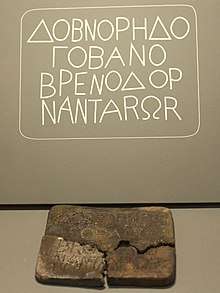Gobannus
Gobannus (or Gobannos, the Gaulish form, sometimes Cobannus) was a Gallo-Roman god, whose name, denoting "the smith", is normally taken to identify him as patron of smiths.

A number of statues dedicated to him are preserved, found together with a bronze cauldron dedicated to Deus Cobannos,[1] in the late 1980s and illegally exported to the USA, now in the Getty Museum in the Getty Center, in California.[2] He is mentioned in an inscription found in the 1970s in Fontenay-près-Vézelay, reading AVG(VSTO) SAC(RVM) [DE]O COBANNO, i.e. dedicated to Augustus and Deus Cobannus.
Etymology
The name is from a Proto-Celtic stem, *goban- 'smith' [3] and can be compared with the Old Irish gobae ~ gobann ‘smith,’ Middle Welsh and Cornish gof ~ gofein ‘smith,’ Gallic gobedbi ‘with the smiths,’ Latin faber ‘smith’ and with the Lithuanian gabija ‘sacred home fire’ and Lithuanian gabus ‘gifted, clever’.[4] The theonym may be an antecedent of Old Irish Goibniu and Middle Welsh Gofannon. In Modern Irish "smith" is gabha, and in Modern Welsh it is gof. Abergavenny, in what is now south east Wales was the site of a Roman fort and settlement called Gobannium.
Gobannus tablet
The best preserved dedication to Gobannus is found on the Bern zinc tablet, where his name is written ΓΟΒΑΝΟ (in the dative and in Greek letters). The tablet was found in the 1980s in Bern. It is inscribed with an apparently Gaulish inscription
- ΔΟΒΝΟΡΗΔΟ ΓΟΒΑΝΟ ΒΡΕΝΟΔΩΡ ΝΑΝΤΑΡΩΡ
Brenodor is probably a placename ( cf. Brennus); Nantaror may refer to the Aare valley (containing as first element nanto- "valley"; [[cf. Cornish nans, Welsh nant). Dobnoredo seems to be an epithet of Gobano, maybe composed of dubno- "world" (Old Irish dumh, c.f. Dumnorix, Donald, Devon) and rēdo- "travel" (Old Irish riad), or rēdā "chariot" i.e. "world-traveller" or "world-charioteer", so that the inscription may mean approximately "to Gobannus, the world-traveller, dedicated by the people of Brennoduron in the Arura valley".
Although called zinc, the tablet is made of an alloy that also contains lead and iron as well as traces of copper, tin and cadmium.[5] The zinc was possibly collected from a furnace, where the metal is known to aggregate, Strabo calling it pseudoarguros "mock silver". In 1546, Georg Agricola re-discovered that a white metal could be condensed and scraped off the walls of a furnace when zinc ores were smelted, but it is believed that it was usually thrown away as worthless. Since the tablet is dedicated to the god of the smiths it is not unlikely that zinc remnants scraped from a furnace were collected by smiths and considered particularly smithcraft-related.
References
- Pollini, J (2002), Gallo-Roman Bronzes and the Process of Romanization: The Cobannus Hoard, Monumenta Graeca et Romana, 9, Leiden: Brill
- US Epigraphy project, inscription number CA.Malibu.JPGM.L.96.AB.54 Archived 2006-09-04 at the Wayback Machine
- Centre for Advanced Welsh and Celtic Studies, Proto-Celtic—English lexicon (PDF), University of Wales
(See also this page for background and disclaimers.) - Blažek, Václav (2008), "Celtic 'smith' and his colleagues", in Lubotsky, Alexander; Schaeken, Jos; Wiedenhof, Jeroen (eds.), Evidence and counter-evidence: Festschrift for F. Kortlandt, Amsterdam–New York: Rodopi, pp. 35–53
- Rehren, Thilo (1996). "A Roman zinc tablet from Bern, Switzerland: reconstruction of the manufacture". Archaeometry 1994 (ISA Ankara).